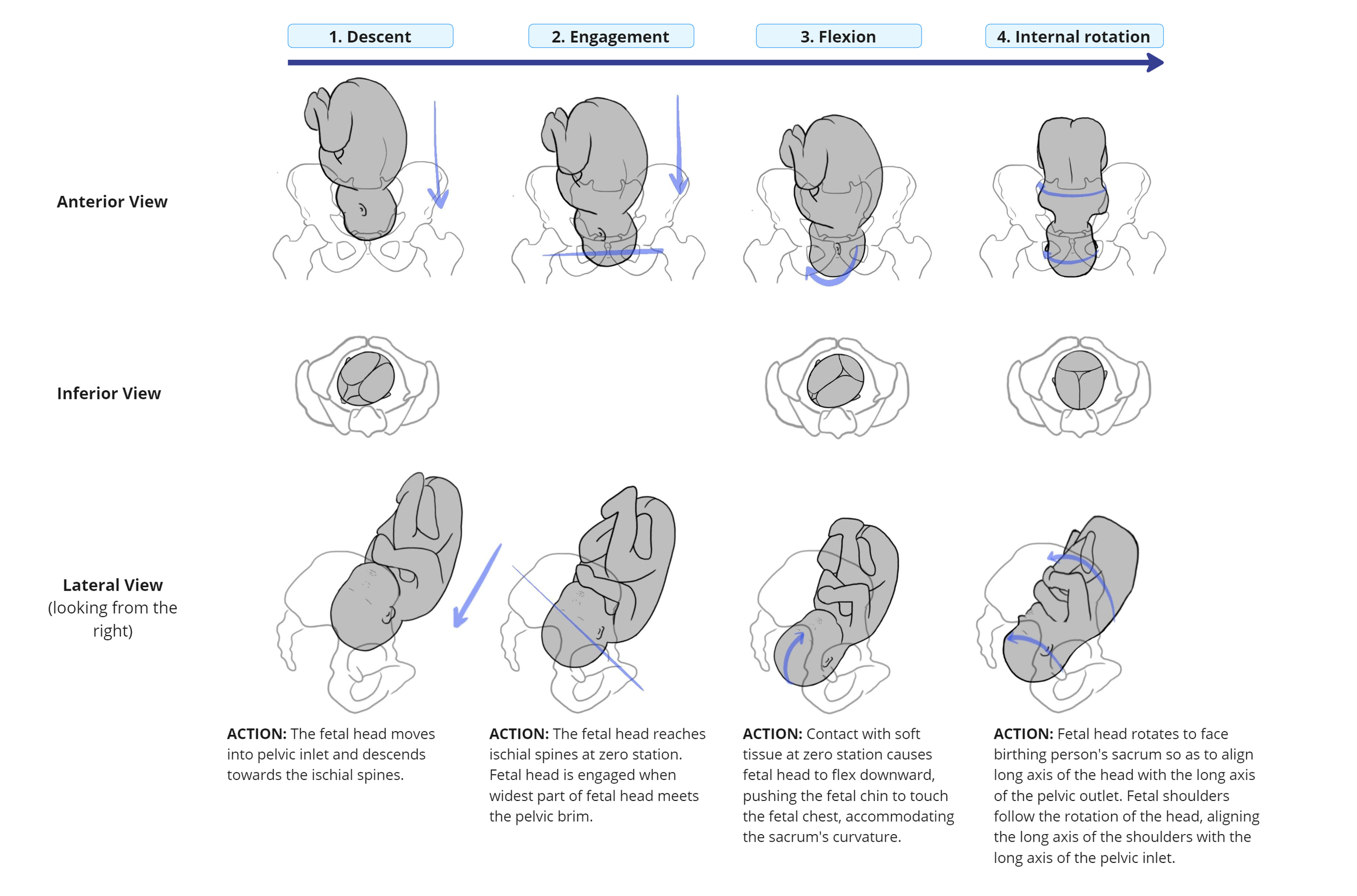Capstone Project
Development of a three-dimensional digital animation for improved understanding of the cardinal movements of labor.
Biomedical Visualization and Communication Certificate Program, University of British Columbia
View the animation at www.clinicalanatomy.ca
Background
Midwifery students need to understand cardinal movements of labor and be able to interpret haptic feedback during birth, a skill difficult to teach through 2D media. Many existing 3D animations depict the supine birth position, making it difficult for students to conceptualize alternative birth positions. These same animations often lack diverse representation.
We developed a 3D animation teaching tool that depicts a fetus progressing through the cardinal movements in the common left occiput anterior (LOA) fetal position. To aid in conceptualizing the fetal body’s position relative to the fontanelle positions, we highlighted the fontanelle edges and the fetal skull sutures throughout the animation.
The Process
Abstract
Development of a three-dimensional digital animation for improved understanding of the cardinal movements of labor
Caite Miller, Beatrix Yu, Katherine Herring, Charita Goyal, Ishan Dixit, Larry Bafia, Kim Campbell, Claudia Krebs
Three-dimensional (3D) animations may improve student recall of anatomical knowledge requiring spatial ability when used as teaching aids in a classroom setting compared to the use of two-dimensional (2D) images alone (Hoyek et al. 2014). Midwifery students must gain a deep understanding of the cardinal movements of labor and the ability to relate haptic feedback from the fontanelles to the fetal position in the maternal pelvis, a skill difficult to teach through 2D media. Existing 3D animations of the cardinal movements often depict the supine birth position, making it difficult for students to conceptualize the cardinal movements in other birth positions. These same animations often lack diverse representation, depicting Caucasian fetuses. To address these gaps, we developed a 3D animation teaching tool that depicts a Black fetus progressing through the cardinal movements in the common left occiput anterior (LOA) fetal position, emphasizing their spatial relation to the pelvis in an upright birth position. To aid in conceptualizing the fetal body’s position relative to the fontanelle positions, we highlighted the fontanelle edges and the fetal skull sutures throughout the animation.
Our animation visualizes eight cardinal movements. The fetus descends, and engagement occurs when the widest part of the fetal head enters the pelvic inlet. Flexion of the head accommodates the curvature of the sacrum, and internal rotation of the head and shoulders follows. The fetus descends further, the shoulders rotate to the oblique position, and the fetal head extends out from under the pubic symphysis. The head restitutes externally to realign with the shoulders. The head and shoulders externally rotate to the anteroposterior (AP) diameter, and the anterior shoulder is born. The posterior shoulder is born by lateral flexion, and expulsion follows.
The Hackspace for Innovation and Visualization in Education (HIVE) at the University of British Columbia provided the fetus, fetal skull, and pelvis models for modification. We used Blender 3D computer graphics software to modify the models and create the animation. Future development involves integrating the current 3D animation into the Pocket Pelvis augmented reality (AR) mobile application, allowing students to learn through hands-on immersive experiences (Dixit et al. 2019). Current 3D assets could be used in similar animations that visualize the typical movements of labor in other birth positions, including physiologic breech presentations. By integrating a library of anatomically accurate 3D animations with user-controlled AR structures, we can create an inclusive, interactive user experience that is an essential tool for midwifery students to gain a deep understanding of the delivery process.
Student Collaborators
-
Medical Illustrator at The Chinese University of Hong Kong
BSc (Hons), Neuroscience and Immunology - University of Toronto
Biomedical Visualization and Communication Certificate - University of British Columbia
-
BSc, Animal Science - North Carolina State University
Biomedical Visualization and Communication Certificate - University of British Columbia
-
BSc, Minor in Fine Arts - University of Waterloo
Biomedical Visualization and Communication Certificate - University of British Columbia




